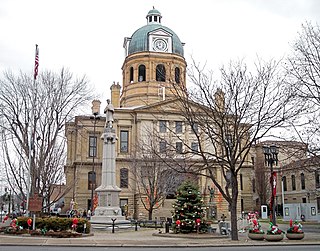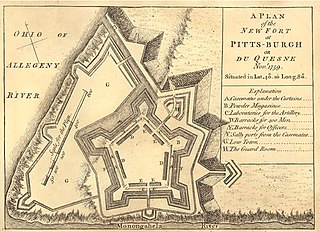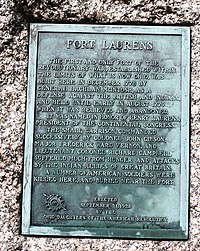
Tuscarawas County is a county located in the northeastern part of the U.S. state of Ohio. As of the 2020 census, the population was 93,263. Its county seat is New Philadelphia. Its name is a Delaware Indian word variously translated as "old town" or "open mouth". Tuscarawas County comprises the New Philadelphia–Dover, OH Micropolitan Statistical Area, which is also included in the Cleveland–Akron–Canton, OH Combined Statistical Area.

George Rogers Clark was an American surveyor, soldier, and militia officer from Virginia who became the highest-ranking American patriot military officer on the northwestern frontier during the American Revolutionary War. He served as leader of the militia in Kentucky throughout much of the war. He is best known for his captures of Kaskaskia (1778) and Vincennes (1779) during the Illinois Campaign, which greatly weakened British influence in the Northwest Territory. The British ceded the entire Northwest Territory to the United States in the 1783 Treaty of Paris, and Clark has often been hailed as the "Conqueror of the Old Northwest".

The Gnadenhutten massacre, also known as the Moravian massacre, was the killing of 96 pacifist Moravian Christian Indians by U.S. militiamen from Pennsylvania, under the command of David Williamson, on March 8, 1782 at the Moravian missionary village of Gnadenhutten, Ohio Country, during the American Revolutionary War.
Leonard Helm was an early pioneer of Kentucky, and a Virginia officer during the American Revolutionary War. Born around 1720 probably in Fauquier County, Virginia, he died in poverty while fighting Native American allies of British troops during one of the last engagements of the Revolutionary War around June 4, 1782 in Jefferson County, Virginia.

William Crawford was an American soldier and surveyor who worked as a western land agent for George Washington. Crawford fought in the French and Indian War and the American Revolutionary War. He was tortured and burned at the stake by American Indians in retaliation for the Gnadenhutten massacre, a notorious slaughter of Indians by militia near the end of the American Revolution.

Henry Bouquet was a Swiss mercenary who rose to prominence in British service during the French and Indian War and Pontiac's War. He is best known for his victory over a Native American force at the Battle of Bushy Run, lifting the siege of Fort Pitt during Pontiac's War. During the conflict Bouquet gained lasting infamy in an exchange of letters with his commanding officer, Jeffery Amherst, who suggested a form of biological warfare in the use of blankets infected with smallpox which were to be distributed to Native Americans. Despite this indictment historians have praised Bouquet for leading British forces in several demanding campaigns on the Western Frontier in which they "protected and rescued" settlers from increasingly frequent attacks.

The siege of Savannah or the Second Battle of Savannah was an encounter of the American Revolutionary War (1775–1783) in 1779. The year before, the city of Savannah, Georgia, had been captured by a British expeditionary corps under Lieutenant-Colonel Archibald Campbell. The siege itself consisted of a joint Franco-American attempt to retake Savannah, from September 16 to October 18, 1779. On October 9 a major assault against the British siege works failed. During the attack, Polish nobleman Count Casimir Pulaski, leading the combined cavalry forces on the American side, was mortally wounded. With the failure of the joint attack, the siege was abandoned, and the British remained in control of Savannah until July 1782, near the end of the war.

The Western theater of the American Revolutionary War (1775–1783) was the area of conflict west of the Appalachian Mountains, the region which became the Northwest Territory of the United States as well as what would become the states of Kentucky, Tennessee, Missouri and Spanish Louisiana. The western war was fought between American Indians with their British allies in Detroit, and American settlers south and east of the Ohio River, and also the Spanish as allies of the latter.

Fort Pitt was a fort built by British forces between 1759 and 1761 during the French and Indian War at the confluence of the Monongahela and Allegheny rivers, where the Ohio River is formed in western Pennsylvania. It was near the site of Fort Duquesne, a French colonial fort built in 1754 as tensions increased between Great Britain and France in both Europe and North America. The French destroyed Fort Duquesne in 1758 when they retreated under British attack.

Fort Meigs was a United States fortification along the Maumee River in what is now Perrysburg, Ohio during the War of 1812. The British Army, supported by Tecumseh's Confederacy, failed to capture the fort during the siege of Fort Meigs. It is named in honor of Ohio governor Return J. Meigs Jr., for his support in providing General William Henry Harrison with militia and supplies for the line of forts along the Old Northwest frontier.

The Treaty of Fort Pitt, also known as the Treaty With the Delawares, the Delaware Treaty, or the Fourth Treaty of Pittsburgh, was signed on September 17, 1778, and was the first formal treaty between the new United States of America and any American Indians, in this case the Lenape, who were called Delaware by American settlers. Although many informal treaties were held with Native Americans during the American Revolution from 1775 to 1783, the first one that resulted in a formal document was signed at Fort Pitt, Pennsylvania, now the site of Downtown Pittsburgh. It was essentially a treaty of military alliance between the Lenape Nation and the United States.

The 1st Rhode Island Regiment was a regiment in the Continental Army raised in Rhode Island during the American Revolutionary War (1775–83). It was one of the few units in the Continental Army to serve through the entire war, from the siege of Boston to the disbanding of the Continental Army on November 3, 1783.
The 8th Pennsylvania Regiment or Mackay's Battalion was an American infantry unit that became part of the Continental Army during the American Revolutionary War. Authorized for frontier defense in July 1776, the eight-company unit was originally called Mackay's Battalion after its commander, Colonel Aeneas Mackay. Transferred to the main army in November 1776, the unit was renamed the 8th Pennsylvania Regiment on 1 January 1777. It completed an epic winter march from western Pennsylvania to New Jersey, though Mackay and his second-in-command both died soon afterward. In March 1777 Colonel Daniel Brodhead assumed command. The regiment was engaged at the Battles of Bound Brook, Brandywine, Paoli, and Germantown in 1777. A body of riflemen were detached from the regiment and fought at Saratoga. Assigned to the Western Department in May 1778, the 8th Pennsylvania gained a ninth company before seeing action near Fort Laurens and in the Sullivan Expedition in 1778 and 1779. The regiment consolidated with the 2nd Pennsylvania Regiment in January 1781 and ceased to exist.
The 3rd South Carolina Regiment was an infantry regiment of the South Carolina Line during the American Revolutionary War. Raised in the western part of South Carolina, the regiment fought in the Siege of Savannah and the Siege of Charleston, surrendering to British forces in the latter.
The 1st Georgia Regiment, or as it was also known, the 1st Georgia was a regiment of the Continental Army, and formed part of the Georgia Line.

Captain Pipe (Lenape), called Konieschquanoheel and also known as Hopocan in Lenape, was an 18th-century chief of the Algonquian-speaking Lenape (Delaware) and a member of the Wolf Clan. He succeeded his maternal uncle Custaloga as chief by 1773. Likely born in present-day Pennsylvania, he later migrated with his people into eastern Ohio.

Fort Shelby was a military fort in Detroit, Michigan that played a significant role in the War of 1812. It was built by the British in 1779 as Fort Lernoult, and was ceded to the United States by the Jay Treaty in 1796. It was renamed Fort Detroit by Secretary of War Henry Dearborn in 1805.

Lachlan McIntosh was a Scottish American military and political leader during the American Revolution and the early United States. In a 1777 duel, he fatally shot Button Gwinnett, a signer of the Declaration of Independence.

Daniel Brodhead was an American military and political leader during the American Revolutionary War and early days of the United States.

Fort Morris is an earthen works fort in Liberty County, Georgia, in the United States. The fort is on a bend in the Medway River and played an important role in the protection of southeast Georgia throughout various conflicts beginning in 1741 and ending in 1865 at the conclusion of the American Civil War, including the French and Indian and American Revolutionary Wars and War of 1812. The historic site is 70 acres (28 ha) in size and sits at an elevation of 23 feet (7.0 m).



















